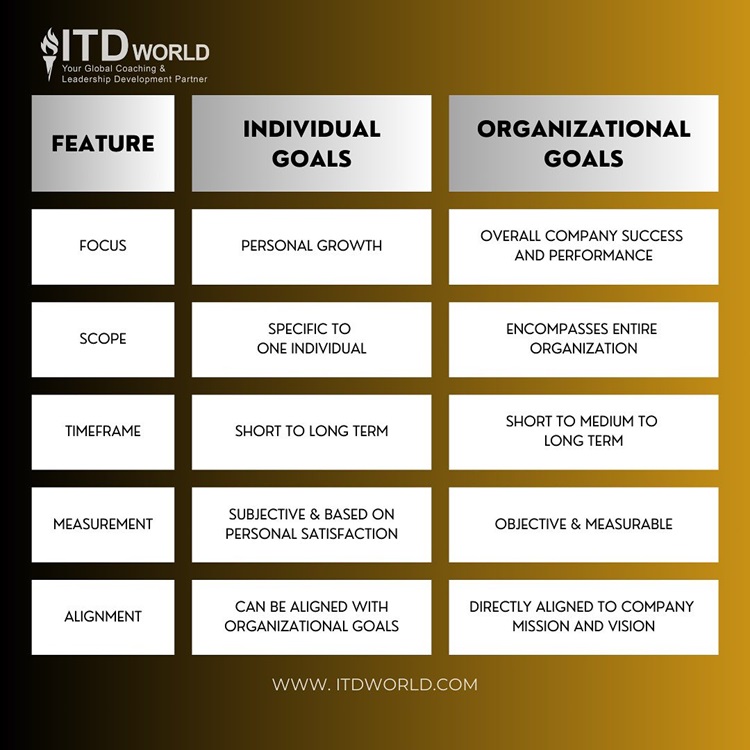Discover how aligning individual goals with organizational goals can transform your workplace. Learn practical strategies to create a unified team, boost engagement, and drive exceptional business results!
Achieving organizational success hinges on the collective efforts of every team member. Aligning individual goals with organizational objectives is the cornerstone of building a high-performing team. When employees understand how their work contributes to the bigger picture, they become more engaged, motivated, and productive.
|
Author: Jonathan M. Pham |
Highlights
- Individual goals and organizational objectives are distinct but interconnected; alignment between the two creates a win-win situation, boosting employee motivation, company performance, and overall success.
- Poor communication, unclear goals, and resistance to change are common problems that hinder the alignment of personal and organizational objectives. To overcome them, individuals should understand themselves and the company, communicate with managers, and be flexible, while organizations should foster a shared vision, encourage collaboration, and implement effective performance management initiatives.
- Effective leadership plays a crucial role in this process by clearly articulating the company’s vision, fostering collaboration, modeling desired behaviors, and providing necessary support.
Individual vs Organizational Goals
Individual goals are personal objectives that an individual sets to achieve. They are often related to personal growth (e.g. learning a new skill), career advancement (e.g. getting promoted, increasing salary), or life aspirations. On the other hand, organizational goals are those set by an organization to achieve its mission and vision; as such, they are typically focused on the overall success and performance of the company. For example:
- Financial: Increase revenue, improve profitability, and reduce costs.
- Market: Increase market share, launch new products, and expand into new markets.
- Operational: Improve efficiency, enhance customer satisfaction, and reduce employee turnover.
| Feature | Individual goals |
Organizational goals
|
| Focus | Personal growth, career advancement, life aspirations |
Overall company success and performance
|
| Scope | Narrower, specific to one person |
Broader, encompassing the entire organization
|
| Timeframe | Short-term to long-term |
Short-term, medium-term, and long-term
|
| Measurement | Often subjective, based on personal satisfaction |
Typically objective, measurable, and quantifiable
|
| Alignment | Can be aligned with organizational goals |
Directly aligned with organizational mission and vision
|
While individual and organizational objectives may seem distinct, they are often interconnected. Alignment between the two results in a sense of purpose and motivation among employees, as their personal aspirations contribute to the company’s success. For instance:
- An individual goal of “improving sales performance” aligns with an organizational goal of “increasing revenue.”
- An individual goal of “developing leadership skills” aligns with an organizational goal of “promoting from within.”

Why is It Important to Align Individual Goals with Organizational Goals?
When individual and organizational goals are aligned, it creates a win-win situation for both the employee and the company that fosters a high-performance culture and drives overall success.
Benefits for the individual
- Sense of purpose
People naturally seek purpose in their work. When employees can connect their daily tasks to a larger, meaningful goal – plus how their role fits into the organizational puzzle, it gives them a sense of ownership and accountability.
- Increased motivation
Aside from external factors like salary or bonuses, people are also driven by internal rewards like satisfaction, accomplishment, and personal growth. Aligning individual goals with organizational ones taps into intrinsic motivation, which translates to higher employee engagement, better productivity, quality work, and lower turnover rates.
- Career growth
When your personal ambitions and the company’s direction are interconnected, it creates a mutually beneficial relationship. You gain valuable experience, skills, and opportunities, while the company benefits from your focused contributions. Over time, a proven track record of contributing to organizational success makes one a strong candidate for leadership positions.
Benefits for the organization
- Improved performance
Alignment in terms of goals ensures that employees are focused on tasks that directly contribute to organizational success, eliminating time spent on unproductive activities. It also fosters a clear understanding of how different roles and departments interconnect, leading to smoother workflows and reduced bottlenecks. In the end, a unified focus on shared objectives increases the likelihood of visualizing organizational goals and outperforming competitors in terms of profitability.
- Enhanced teamwork
A common goal creates a sense of unity and camaraderie among employees. As a result, communication becomes clearer and more effective, laying the foundation for a culture of trust and cooperation where everyone relies on each other.
- Better decision-making
When employees understand how their work contributes to the broader company objectives, they are better equipped to make decisions that support those goals. Decisions about task prioritization and resource distribution are made with the big picture in mind, ensuring optimal use of assets. In addition, people are more likely to consider how their decisions impact other departments and the entire organization in the long run.
Read more: Coaching Culture – Blueprint for Organizational Growth

Challenges of Aligning Individual Goals With Organizational Goals
- Lack of communication
Information silos, where departments operate in isolation, restrict the flow of crucial information and understanding of the company’s broader objectives. Moreover, complex organizational structures often create barriers, with information getting distorted or lost as it travels through multiple layers. Inconsistent messaging from different leaders further exacerbates the issue, leaving employees confused about the organization’s priorities. When team members are unaware of the company’s overall strategy and how they play a role in it, disconnection is sure to follow.
- Misalignment of goals
Ambiguous or unclear goals often lead to misunderstandings and misdirected efforts. Additionally, conflicting priorities between individuals and teams can create tension and hinder progress toward shared objectives.
People naturally fear the unknown, potential job insecurity, or disruptions to their routines associated with change. They may also hold onto established ways of working, making it difficult to adopt new processes or technologies. If employees don’t understand the rationale behind the change or how it benefits them personally, they are less likely to embrace it.
Overcoming this challenge requires open communication, addressing concerns, providing adequate training and support, and demonstrating how the change aligns with individual goals and the organization’s overall success.
Read more: Change Management – Best Practices for Leading Organizational Transformation

Tips for Aligning Individual Goals With Organizational Goals
For individuals
-
Knowing oneself & the company
The core idea behind this approach is to ensure one’s personal objectives align with the broader company direction. When the two are interconnected, it creates a synergistic effect, boosting overall productivity and job satisfaction.
Understand the company’s vision: A clear understanding of the following elements provides a solid foundation for goal alignment:
- Mission: The company’s purpose and reason for existence – why it operates.
- Vision: The desired future state of the organization – where it wants to be.
- Values: The guiding principles that shape the company’s culture and decision-making.
Connect your goals to the company’s objectives:
- Identify overlaps: Determine how your role and responsibilities contribute to the company’s mission and vision.
- Set aligned objectives: Create personal goals that directly support those of the company. For instance, if the organization aims to increase customer satisfaction, your goal might be to improve customer response times.
- Measure impact: Track your progress and evaluate how your achievements contribute to the overall success.
Example:
If a company’s vision is to become the leading sustainable fashion brand, a marketing manager’s goals might include:
- Increasing brand awareness among environmentally conscious consumers.
- Developing marketing campaigns that highlight the brand’s sustainable practices.
- Building partnerships with eco-friendly influencers.
-
Communicate with one’s manager
Open and honest communication is crucial for aligning individual and organizational goals. Your manager has a broader perspective of the company’s objectives and can provide valuable insights into how your role fits into the bigger picture, clarification of expectations, resource allocation tips, suggestions for your career growth plan, etc.
Effective communication with your manager is a two-way street. It involves both sharing your goals and actively listening to their feedback and guidance. This collaborative approach fosters a strong working relationship and increases the likelihood of achieving both individual and organizational success.
-
Be flexible
The business landscape is constantly evolving. What was a top priority six months ago might be less critical today. This is why flexibility is crucial when aligning individual goals with organizational objectives. It doesn’t mean abandoning long-term career goals; rather, it’s about finding ways to align one’s aspirations with the company’s evolving direction.
Now, let’s say a tech startup, initially focused on developing a mobile app for food delivery, set out the following goals for the marketing manager:
- Increase food delivery app downloads by 20%
- Improve app rating to 4.5 stars
- Expand user base in three new cities
Due to increasing competition and changing consumer preferences, the company decided to pivot and focus on developing a meal-kit delivery service – which deviates from the original objectives above. In this case, the marketing manager may do the following things to adapt to changing priorities:
- Stay informed: They attend company meetings where the pivot is discussed, and spend time researching the meal-kit delivery market and competitor strategies.
- Communicate openly: They schedule a meeting with their supervisor to discuss how their role and goals align with the new focus. They express interest in taking on new challenges and contributing to the company’s success.
- Prioritize effectively: The marketing manager shifts their focus to developing a brand identity and marketing strategy for the meal-kit service. They allocate resources to create compelling content and social media campaigns targeting a new customer segment.
- Embrace change: They view the pivot as an opportunity to showcase their adaptability and learn new skills. They actively seek out training and development opportunities related to meal-kit marketing.
- Maintain long-term goals: While the immediate focus is on the meal-kit service, the marketing manager continues to develop their skills in digital marketing and brand management, which are transferable to future roles within the company.
For organizations
-
Shared vision & clear communication
By transparently sharing organizational objectives with all team members, companies create a shared vision that inspires and directs efforts. Open dialogue empowers individuals to understand how their work contributes to the bigger picture, fostering a sense of purpose and ownership.
On the other hand, regular updates on organizational performance keep employees informed, engaged, and aligned with the company’s trajectory, ensuring that individual goals remain relevant and contribute effectively to overall success.
Read more: Transparent Leadership – Finding the Right Balance
-
Collaborative goal setting
Organizations need to encourage team members to participate in the goal-setting process – so that those from all levels may work cohesively toward a common set of targets. The implementation of SMART goals (Specific, Measurable, Achievable, Relevant, and Time-bound) provides clarity, focus, and accountability, maximizing the impact of collective efforts.
-
Performance management
Regular performance reviews give organizations the chance to assess employee progress and identify areas where individual efforts may be better aligned with broader objectives. This approach should be combined with continuous feedback to better empower everyone and offer them guidance for improvement. Recognizing and rewarding achievements is crucial to reinforce positive behaviors that support organizational goals, further strengthening the connection between individual and company aspirations.
The Role of Leadership in Aligning Individual Goals With Organizational Goals
Effective leadership is paramount in ensuring that individual aspirations harmonize with the broader organizational objectives. By clearly articulating the company’s mission, vision, and values, leaders provide a compass for team members to navigate their roles. When employees understand how their contributions fit into the larger picture, they are more likely to feel engaged and motivated.
Example:
A case in point is a tech startup that emphasizes innovation. The CEO, in town halls, vividly describes how each team’s breakthroughs contribute to the company’s goal of revolutionizing the industry. This clarity inspires employees to approach their work with a sense of purpose.
Furthermore, fostering a collaborative environment is essential for aligning individual and organizational goals. Leaders who create safe spaces for open dialogue encourage people to share their perspectives and contribute to goal-setting. This inclusive approach not only boosts morale but also ensures that diverse viewpoints are considered.
By modeling desired behaviors and demonstrating a strong commitment to organizational goals, leaders inspire their teams to follow suit. For instance, a CEO who consistently prioritizes customer satisfaction sets a clear expectation for the entire company, encouraging employees to go the extra mile to deliver exceptional service. At the same time, the management should remember to provide the necessary support for employees to succeed. This includes allocating resources, offering training and coaching, and providing regular feedback.
Read more: Employee Skill Development – Strategies for Organizations to Boost the Bottom Line

Other resources you might be interested in:
- Leadership Branding: Crafting an Inspiring Personal Identity
- Organizational Transformation: An Essential Guide
- Talent Management: Mastering the Basics for Success
- Talent Development Playbook: Building Your Future Workforce
- Employee Wellbeing in the Workplace: Practical Strategies

